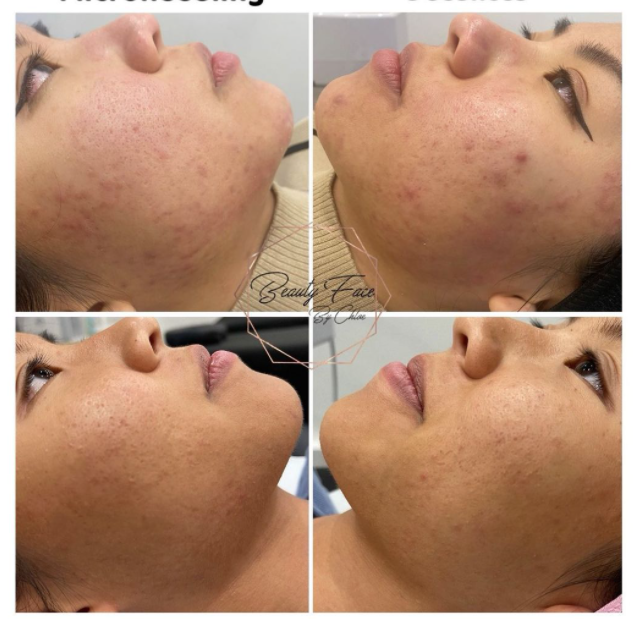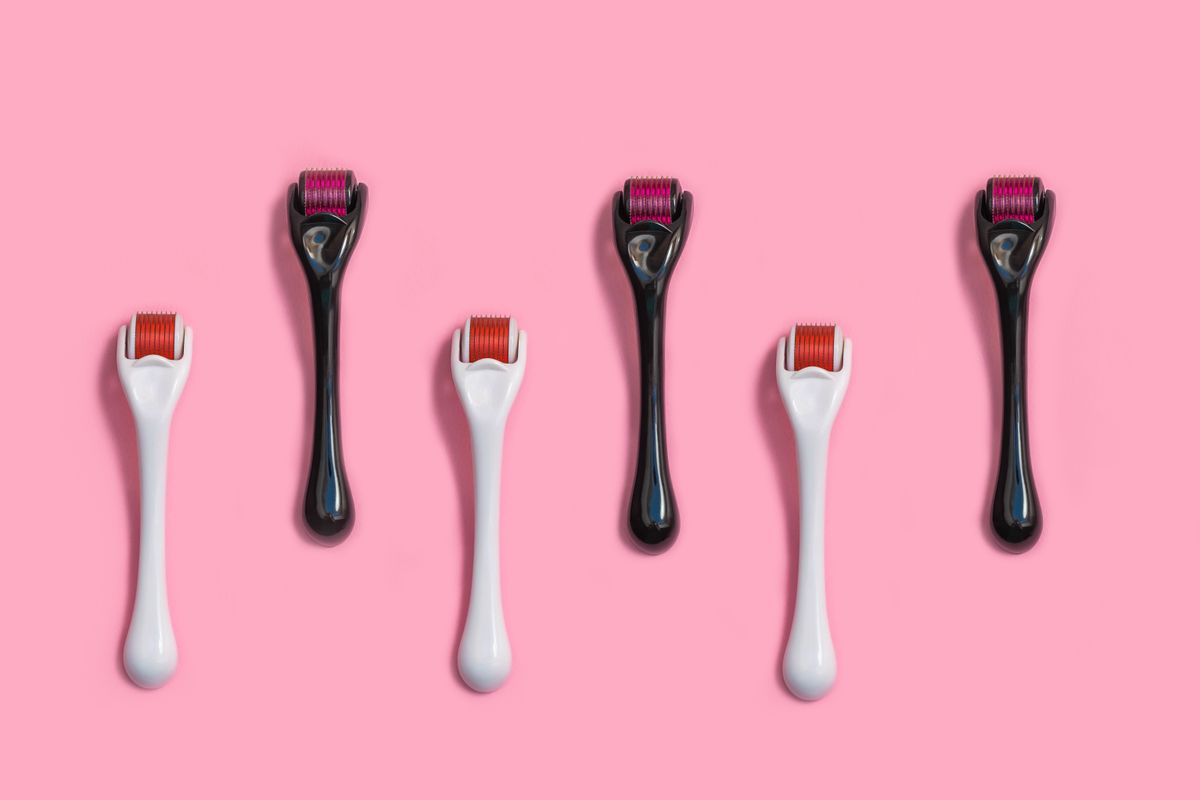Do you suffer from bad skin texture, large pores, fine lines, or pesky acne scars? If you’ve been on the lookout for a solution to these issues, then you’ve probably heard of microneedling already. Microneedling is touted as one of the gold standard treatments for addressing texture issues. It is a popular dermatological procedure that promises smoother, firmer, and even-toned skin.
As the name suggests, the procedure uses a dermarolling device with a bunch of tiny needles that are used to puncture the skin. The purpose of the needling is to cause ‘micro injuries to the skin to induce the natural process of collagen production and skin rejuvenation. When the skin starts to rebuild itself after these micro-injuries, it creates new collagen-rich tissue. As a result, the skin becomes firmer, smoother, and more elastic compared to the skin before microneedling.
How it Works
Microneedling is a type of non-invasive collagen induction therapy. Microneedling treatment can either be done using a derma roller or a micropen. When the needles prick the surface of the skin, micro-wounds are created which triggers superficial inflammation. Inflammation is considered as the body’s natural healing response which visually translates to plumper-looking skin.
By causing micro-wounds, the skin also becomes more absorbent to other skincare and topical facial treatments. This is why most microneedling sessions end with an application of skin-caring creams, serums, or masks. Long-term, microneedling also stimulates the production of collagen.
The Skin Care Benefits of Microneedling Treatments
Collagen is a natural protein that exists in the body that provides structure to our skin among other functions. Aging, an unhealthy diet, and poor lifestyle choices can affect the quantity and quality of the collagen we produce. By improving our body’s collagen production, we can retain firmer younger looking skin and avoid most texture issues. Microneedling, through collagen induction, can help address the following issues:
- Acne scars
- Enlarged pores
- Blemishes or post-inflammatory hyperpigmentation
- Sun damage
- Sagging skin
- Fine lines and wrinkles
- Uneven skin tone
- Stretch marks
- Surgical scars
- Age Spots

Is Microneedling for your skin?
Do you suffer from any of the above issues? If you’re religiously following a solid skincare regimen and still not seeing results, then it might be worth giving microneedling treatment a shot. Microneedling can be done either at home or through a derm clinic.
It’s generally safe for most people unless you suffer from eczema, rosacea, perioral dermatitis, or have highly sensitive skin. If you are pregnant and have a history of skin scarring, it’s also best to skip microneedling. For acne and stretch marks treatment, microneedling is also best performed by a professional.
How much does microneedling near me cost?
The cost of microneedling varies greatly depending on your issue and the size of the treatment area. The type of device used in the procedure also plays into the cost. Home dermarollers can cost as little as $30 and go as high up to $300.
For clinical treatments, expect to shell out anywhere between $100 to $700 per session. Make sure to go to a licensed dermatologist that’s board-certified and practicing in a sterilized clinic. Estheticians can perform microneedling but can only do so with devices of less than 0.3 mm that don’t penetrate the skin as deeply. This depth is not enough and won’t be as effective in treating many skin issues.
Dermarollers vs. Micropens
As mentioned, microneedling can be performed either with a dermaroller or a micropen. A dermaroller is a handheld tool with a rotating cylinder head lined with needles and is rolled across the skin. Dermarollers come in different sizes, with needles ranging from 0.2mm to as much as 2.5mm. They are generally cheaper than micropens and can be purchased for at-home use.
Most professional microneedling services use a micropen which is a handheld motor-powered device equipped with fine needles. They are more expensive but they provide several benefits over a dermaroller. Different skin issues require different depths of puncturing penetration which can be addressed by a micropen. With a dermaroller, the length of the needles are fixed so addressing different issues would require several replacement heads or devices altogether.
Micropens are also less traumatic on the skin as they puncture the skin in a clean, vertical wound. The way dermarollers are designed, the needles insert to the skin at an angle which also affects the depth of treatment. Because of the design of the cylindrical head, it’s also harder to treat hard to reach areas with a dermaroller. Micropens allow better access to areas like the sides of the nose, around the eyes, or upper lip. The disposable tips also make them more sanitary which is a non-negotiable requirement for derm clinics.
How to prep for the treatment
Once you decide to book your first microneedling treatment appointment, your practitioner should give you tips on how to prep before the procedure. In general, it’s advised to stop any harsh products at least a week before your session. Shelf your retinoids, acids, and exfoliators for the time being.
What to expect during the treatment
If you are a first-timer, expect to go through a short skin consultation prior to the procedure. This is the best time to ask questions from your doctor and also to share which skin concerns you particularly want to treat and target. Once you’re cleared to undergo microneedling treatments, your derm will clean your face then apply a topical numbing cream. After about 20 to 30 minutes, the actual microneedling procedure will begin.
Does it hurt? The pain is very minimal thanks to the numbing cream but expect to still feel some discomfort. Bony areas like the forehead, jawline and hairline area are generally the most sensitive. The sensation feels a bit scratchy more than it hurts. It kind of feels like running an electric toothbrush over the face because of the micropen’s vibrations.
The microneedling procedure takes approximately 30 minutes. You may experience some redness, pinpoint bleeding and some burning sensation when the numbing cream wears off but this isn’t a cause for concern. After the microneedling, your dermatologist will apply a mask or a serum over the face that promotes hydration and skin repair. Once that sinks in then you’re all good to go!
What to expect after Microneedling
One of the best things about microneedling is perhaps the lack of downtime. You’ll leave the clinic a bit red but your skin should calm down in just a few hours. Feel free to resume normal activities but do avoid sun exposure, swimming, and a sweat session for at least 72 hours. Dial down on the strong actives in your skincare for about a week, as well as exfoliating and using powered cleansing brushes.
Your skin might feel itchy the first few days as you start to heal and rejuvenate. This is not a cause for concern and should feel better with some moisturizer application.
You can see results as soon as you walk out of the clinic as the superficial inflammation should make your skin look plump and radiant. After a few days, you’ll notice a renewed radiance and softness to the skin, as well as smaller pores, reduced acne scars, and less defined lines. During this time, you might also notice that your skin care now absorbs better.
Skin rejuvenation takes time so allow your skin at least a week to heal fully so you can enjoy the positive effects of the procedure. Most users report firm, even-toned, and radiant skin after just one session. These results can last for around four to six weeks depending on your skin and lifestyle. In general, try to avoid sun exposure and keep yourself hydrated and well-rested.
How often should you do the treatment?
Microneedling can be a one-time thing but your skin will definitely benefit from regular sessions. If you take care of your skin and don’t have any major texture issues, you can enjoy a microneedling session every six months to once a year. For more severe skin issues, like acne and acne scarring, your doctor may suggest several treatments spaced six weeks apart.
Risks and side effects the treatment
Like all cosmetic procedures, microneedling is not without risks or any side effects. Redness and itchiness are common following a few days after your appointment, but call your doctor if you experience any bleeding, bruising, or infection. The risks are fortunately extremely low.
Final thoughts
Microneedling is a great cosmetic procedure that can target a wide range of issues such as uneven skin tone, fine lines, and rough skin texture. It is non-invasive and is generally considered safe, but be prepared to spend a good sum on the treatment. It requires practically no downtime and the results are immediate and can last for four to six weeks. If you’ve stuck to a solid skincare routine and nothing works, then consider giving microneedling a try.
FAQ
Does microneedling help with acne scars?
Microneedling does help with acne scars. microneedling helps to increase the production of collagen which can fade away stretch marks and also reduce scarring.
How long does microneedling take?
The microneedling procedure takes around 30 minutes on average but this may vary from one person to another. It's usually done just before lunch so that after the procedure, you can be on your way.
How much does microneedling cost?
The cost of a microneedling treatment will depend on the experience and expertise of the dermatologist or aesthetician who performs it.
Does microneedling hurt?
There may be some pain or discomfort during a microneedling treatment, but this shouldn't last for too long. It's also accompanied by topical anesthesia to ensure that your procedure is as comfortable as possible.
What does microneedling do?
Microneedling helps the body create new skin cells and grow collagen in order to improve fine lines, wrinkles, age spots, and other common signs of skin aging.
What is microneedling?
Microneedling uses a medical-grade device to create thousands of tiny channels in the top layer of your skin. These micro-channels stimulate collagen growth and encourage new cell regeneration, which can make your skin appear younger.
Does microneedling help acne scars?
Yes, microneedling is a great treatment for acne scars as it can promote new collagen production. This in turn will reduce the appearance of existing acne scarring and pigmentation issues.
What are the benefits of microneedling with PRP?
Adding platelets to your microneedling treatment will further enhance the benefits you receive from this procedure. Platelets are loaded with growth factors and anti-inflammatory proteins that can help reduce acne scars, fine lines, and other skin issues.
What is microneedling used for?
Microneedling is a great treatment for fine lines, aging skin, acne scarring, stretch marks, wrinkles, and just about any other skin condition.
Can microneedling ruin your skin?
Micro needling can actually help improve the health of your skin by stimulating collagen production and promoting skin cell growth.
How do I find a good microneedling near me?
The quality of a microneedling treatment will depend on your dermatologist. Ensure to research their credentials and experience before committing to an appointment.
Do dermatologists recommend microneedling?
Yes, dermatologists recommend microneedling because it can rejuvenate and transform your skin.
How to do microneedling at home?
There are many products available that you can use for DIY microneedling treatments such as derma rollers. But before using any of these tools, ensure that you read reviews and conduct proper research on them.
How long does microneedling last?
Microneedling can provide you with long-lasting results because it stimulates collagen production and improves the overall health of your skin. However, due to natural aging and issues like sun exposure, these results will eventually fade over time.
What age is best for microneedling?
Although microneedling can be performed at any age, most dermatologists recommend starting treatment in your 20s and 30s to see optimal results.
How long does it take to see results from micro needling?
It can take around three weeks for you to see the first signs of improvement, and these results will only continue to improve as time goes on.
Does microneedling really work?
Yes, microneedling can help treat a wide range of skin issues and rejuvenate your complexion.
How to care for skin after microneedling?
After your procedure, you'll need to take good care of your skin in order to maintain the benefits that you received from the treatment. This includes using sunscreen daily as well as avoiding the sun, not smoking, and more.





